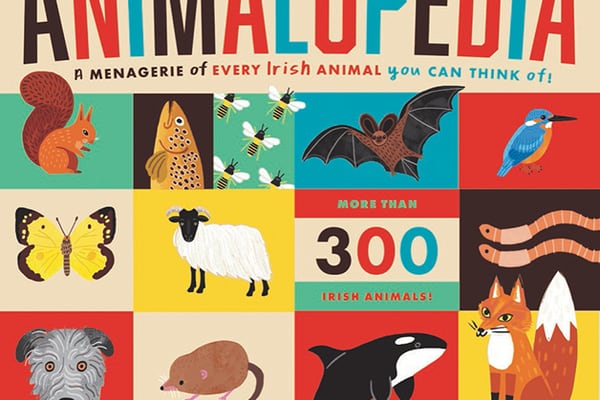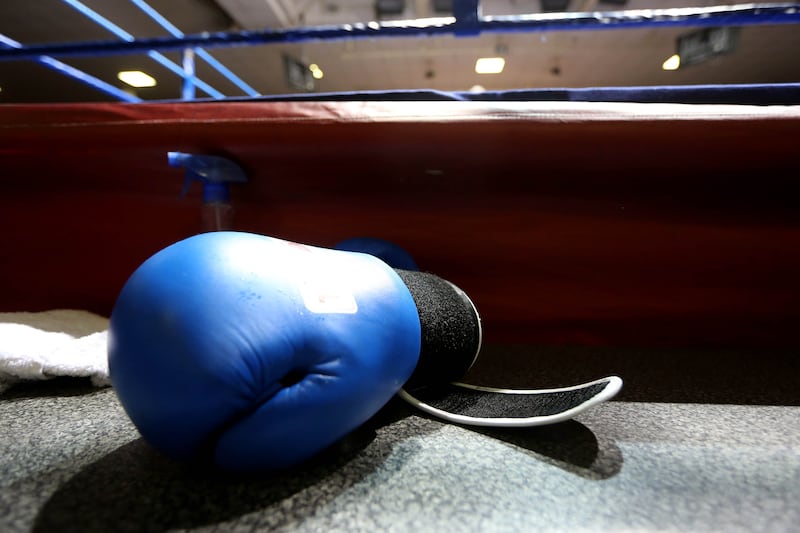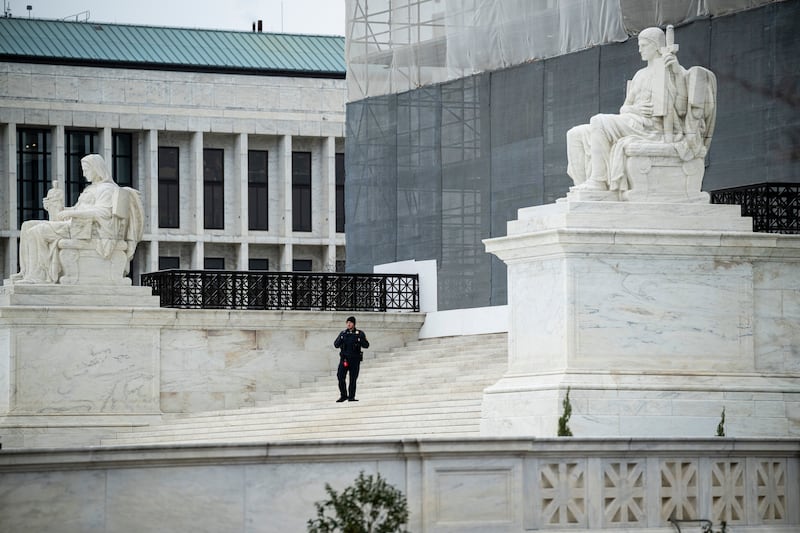There is a low hill in Marlay Park near the children’s playground. It is a spoil mountain made of soil and rock, excavated when the M50 was built. This unromantic leftover is becoming a wild (and Wildean) place. A labyrinth has been mown through ribbon rows of close-planted native trees. At the top a sculpture of a face by Agnes Conway is set in the ground like a sleeping goddess under a green blanket. Her nose is regularly clambered on by the children who drift from the playground to the top of the mound.
The young trees sway happily in their river of tall grass. They are vigorous thrivers: hazel, spindle, crab apple, hawthorn and blackthorn, great at greening ground left by large earth movers. Millennia ago it was glaciers doing the moving rather than dump trucks.
Assistant foreman gardener Louise Connolly planted the labyrinth in the cold grip of winter. She does her best planting in winter. She hopes the canopy will tunnel in another few years to bring people up close and personal with a native hedgerow. In future summers the labyrinth should be heady with the honey smell of hawthorn blossom.

Connolly is wearing her knee pads when I arrive at Marlay House to talk to her about wilding public places. Hip trouble means she walks with a light crutch. It doesn’t stop her hopping in and out of her veteran John Deere Gator with more agility than me. After 36 years with the parks service she is in her element. There is a sense of flow, like she is harnessed to a natural system. “Now I’m gardening the way I gardened at home,” she says. “It’s such a joy. How could you not enjoy it?”
READ MORE
Practices changed in the 300-acre suburban park in south Dublin four years ago when Dún Laoghaire Rathdown County Council went chemical-free. Until then glyphosate was routinely used to kill off green areas for replanting. Summer bedding plants were brought in to replace spring bedding. “These plants were very highly bred for their bling effect,” says Connolly. They stayed for three months and were then removed before the soil was dug over again. “It was a waste of money, time and effort.”
The “big rethink” started with seeding a grassy area near the courtyard with wildflowers. It had plenty of poppies and colour in the first year, but then it grew less vibrant as docks and other plants came along to help the soil recover from being rotavated. “We decided we’re not going to dig anymore,” Connolly explains. Now she mulches new planting areas with tonnes of recycled Christmas tree chip. It smothers grass and creates space for gently curving rivers of perennial plants.
[ Want to be a ‘rewilder’? Here’s howOpens in new window ]
There are drifts of forget-me-nots, the tiny starry woodruff flowers, a line of comfrey along by the old buildings. There are wild plants in the mix, like dead nettle and burdock in a flow of gorgeous colour under a cedar that is more than a century old. “There was nothing here because nothing grew here before,” she says.
I’m visiting in May; the spring bulbs are dying back and summer flowers are beginning. “One thing finishes and something else will come in. Eventually it’ll take care of itself.”
In the walled garden her gardener colleague Paul Burke has created a series of no-dig beds where he is growing perennial flowering plants for the park, along with vegetable crops. His plan is to create a meadow-like food garden, loosening rigid ideas of walled kitchen gardens.
Connolly’s planting under the trees isn’t wild. “It’s naturalistic. They’re not wild plants but this is a park,” she says.
And people love it. It’s a haven for birds and insects. Ground ivy provides cover for small mammals. Not mowing under certain trees has meant that they can seed themselves. The wild-seeded trees will be moved in dormant season to the labyrinth. Connolly’s colleague who opens the park early in the morning has noticed an increase in bird life. “We have so many more finches than we used to.”
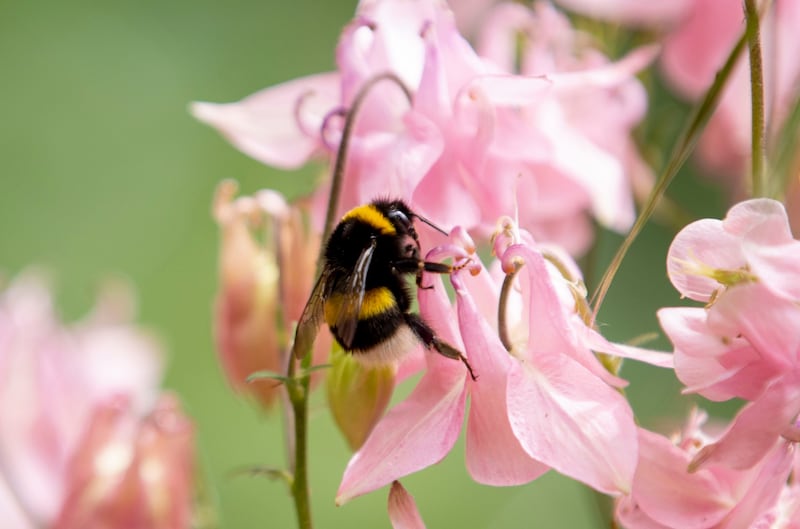
Elsewhere in the park a full meadow is thronged with plantains waving their brown soldier heads in a haze of dandelion fluff. The meadow is bordered with veteran trees. Marlay has “great bones”, Connolly says. “All we’re doing is dressing it up.”
A mown path allows people to walk through it. Nettles and cow parsley throng the tree line, a wild meadow in suburbia, no-mow at scale. It is cut once a year. A farmer from Tallaght will take a hay crop in the early autumn.
Our idea of a park, like our idea of Christmas, has been heavily influenced by the Victorians. Manicured lawns, bling bedding plants and exotic specimens were ostentatious shows of wealth and colonial domination. They kept it all spick and span with loads of staff and money, says Connolly. The long-gone armies of weeders, clippers and scythers were replaced with fossil fuel-driven machines and chemical bioweapons to maintain rigid straight lines. Bourgeois big house gardens came to the burbs. In a biodiversity and climate crisis where we understand the cost of that shortcut, new practices are needed. “The Victorians have had their day,” Connolly says.
Credit for the shift in how public land is being managed has to go to the All-Ireland Pollinator Plan, first published in 2015 by Trinity professor Jane Stout and Dr Una Fitzpatrick, senior ecologist with the National Biodiversity Data Centre, with detailed recommendations for councils, transport authorities, businesses, schools, sports clubs, farmers and individuals. Each section contains a range of suggestions for “pollinator-friendly actions”, from leaving grass verges along roads and motorways unmown, to creating wildflower meadows, protecting nesting habitats and reducing the use of pesticides.
[ Rewilding Irish landscape would bring big benefits ‘for nature and humans’Opens in new window ]
More than half of all local authorities have endorsed the plan and agreed to take specific actions. But it remains a series of recommendations rather than regulations. Until recently full-time staff dedicated to the plan in the National Parks and Wildlife Service and the Department of Agriculture have been promised rather than delivered. It is dependent on partners signing up.
New recommendations are expected to come from the Citizens Assembly on Biodiversity Loss, and the Government has promised those recommendations will inform a policy on biodiversity which will hopefully make nature-friendly land management the way in which things are done.
The term rewilding is believed to have first been used by a Newsweek journalist writing about radical environmentalism in 1990. The idea was described as “letting nature take the lead” by wilderness advocate Zoltan Kun in a recent webinar with the Irish Wildlife Trust. Rewilding can be big or small: from naturally regenerating thousands of hectares by fencing or introducing wolves, to putting the mower away so suburban soil can find its mojo.
It can be as small as a window box with local soil and a nettle and a thistle planted in it to allow us to watch the spidery creatures, caterpillars and tiny hovering insects that need unloved plants for a home.
The last idea is from garden designer Mary Reynolds. She designs “arks”, or Acts of Restorative Kindness, rather than gardens now. She is convinced that the future will be ark-shaped with nature at the prow.

Ideas of control are hard to relinquish. Ireland has a history of locking up wildness and throwing away the key. Weedy unkempt places have associations of poverty. Letting the land go was a visible sign of defeat or grief for many people, the loss of loved ones through bereavement or emigration. Prosperity has been drawn on the landscape with ripped-out hedgerows and a blank green carpet of heavily-fertilised rye grass. We need a new story about wild places.
It’s 20 years since Reynolds won a gold medal at the Chelsea Flower Show, becoming the youngest woman ever to win. Her success sent a dart of hope through environmentalists’ hearts that the days of laurel hedges and scalped lawns were numbered. Woolly, wavey gardens full of native plants would be planted with pride.
Reynolds was taken aback by the emotion that greeted her garden, a stone archway opening to a path with four Druid thrones around a fire bowl over a pond with more than 500 native plants. People were moved to tears.
“It was something they didn’t know that they had lost until they saw it kind of honoured,” she explains. “One old lady – she was one of the lost Irish – had come to work as a cleaner aged 17 and was then in her 80s … started crying her eyes out. She had never managed to get back to Ireland and she knew she was never going to get back but now she felt she had been back.”
In 2018 Reynolds founded We Are The Ark, to guide people to return gardens to nature to combat biodiversity loss. Her website gives a simple how-to for anyone who wants to build a natural haven which will sustain itself. A key step is to put up a sign “This is an ark” to explain what some may see as a messy place.
Reynolds’ mission is to persuade people of our innate “ability to connect with nature, with land and with creatures. We seem to think we are completely separate.”
“I know that I’d be considered a complete lunatic in many ways but I’m very sure that the future is what I do. If you want to save the planet you have to start with your own patch … we have to stop imposing our view of what should be in the ground on top of the earth. We have to let her decide.”
Creating an ark is dependent on how much damage the soil has undergone. “It definitely can need a lot of help. Sometimes the damage is so profound that we have to restore it as much as we can.”
Central to the idea is providing “as many different layers of habitat as you can within the space you have”. In “arking”, as Reynolds call it, humans step in to be the creatures like wolves and deer that balance a habitat. Larger spaces can accommodate multiple habitats: scrubby areas where brambles are allowed to spread into “native thorny thickets”. A pond can be a bowl of water with some oxygenating plants in it. Dead hedges, piles of logs can provide places of sanctuary. Holes in boundaries between gardens, fences replaced with hedgerows.
“How amazing Ireland would be if we were covered in our own plants, if we didn’t decide to import things that were pretty?” Reynolds asks. “How do we think we always need to be like someone else?”
[ How the baron of Dunsany carried out an ambitious rewilding project in MeathOpens in new window ]
The gardening industry has made a grab for rewilding trends with wildflower seed mixes, packets showing a riot of colour, most of which are not native plants. “If we keep doing what garden centres tell us to do, those big showy flowers, they’re like big fat signs for McDonald’s,” says Reynolds. The insects flock to them, so the more insignificant but far more vital native plants fail to find space or pollinators. We are prettifying ourselves to extinction.
“We need our hearts open to include every little wild weed.” Leave spaces to find their way, is her advice. “Docks will come up, thistles will come up. Nature is very intelligent and knows how to heal itself.”
If your soil seedbank is depleted and you have to sow, new seeds should be native grown and wild, or better still, gathered from your neighbourhood in late summer and autumn. A useful intervention can be to scrape some bare soil in a lawn and sow yellow rattle seeds, Reynolds says. Yellow rattle roots strangle grass roots and spread throughout a field or lawn, making space for wild seeds to germinate and grow.
Reynolds has a new book coming out in October called We Are the Ark. Over the next four years she will be working on a flagship ark in the grounds of Westport House in Co Mayo. Everything will be sourced from within 16km. “We will be holding nature in a new light. It’s the god of everything we are. We’re screwed without our home,” she says. “I don’t want to go and live with Elon Musk on Mars.”
Twenty years on she “can’t bear the Chelsea Flower Show now”. It’s part of an industry that has become a juggernaut, paving gardens with Chinese granite and stone from India. “Invasive plants and non-native plants are taking away the food supply of our fellow creatures.”
This year Chelsea’s best-in-show garden was an echo of Reynolds’ win, with the award going to a garden sponsored by Rewilding Britain. Lulu Urquhart and Adam Hunt recreated a beaver dam, using wild plants, grasses and native trees. Like a deliberately tousled hairstyle, it looked like a quiet green corner of countryside undisturbed by people or other large animals.
In the two decades since Reynolds’ win, the plastic grass industry has marched across multiple gardens. “You never have to force this [ark creation] on anyone,” she says. The freedom to choose it is part of the message. And her take on plastic grass? “Eventually some brave politician will step in and make that illegal.”

In the middle of writing this piece I opened Clarissa Pinkola Estés book Women who Run with The Wolves, to one of the many pages I dog-earred while reading it. “When we think of reclamation it may bring to mind bulldozers or carpenters, the restoration of an old structure, and that is the modern usage of the word. However, the older meaning is this: The word reclamation is derived from the old French reclaimer, meaning ‘to call back the hawk which has been let fly’. Yes, to cause something of the wild to return when it is called.”
Call it reclamation or rewilding, the trend is a very positive one, ecologist and environmental scientist Pádraic Fogarty of the Irish Wildlife Trust says. “It has enormous potential.” Ironically “one of the barriers to it is that it’s too cheap and too easy. Nature just needs some time and space.” This goes against our need for immediate results.
Fogarty has a cherry tree in his garden “that found its way there”. But outside his house this morning, three tractors have been cutting acres of grass in the Dublin estate where he lives, obliterating any chance of another bird-sown cherry seed making it to treedom. We need to “reverse the mentality around mowing, and mow only the places where people want to play football or picnic”, he says.
The National Pollinator Plan has “done wonders for making people look at things differently”, Fogarty says. Public spaces offer an institutional opportunity to make spaces where trees “are allowed just to grow themselves”. Deer fencing in the Phoenix Park would allow areas to become forests.
“They’re still planting non-native trees in the Phoenix Park,” Fogarty says. It’s his nearest park. They say the Mediterranean oaks are being planted to replace veteran trees as part of a managed landscape, he says. But, “should we be keeping the park absolutely identical to what it was in the 1700s?”
We talk on the day that the EU has announced a plan to plant three billion trees. As part of Project Woodland, the Irish Wildlife Trust has been consulting on the next forest strategy for Ireland, due to be published soon. The key question, Fogarty says, is how we are going to meet some of the targets. Natural regeneration where trees seed themselves could help to re-establish native woodlands with a power and speed unmatchable by our efforts. “The idea that we need to plant three billion trees is so human-centric. What we need to do is establish forests, large areas of forest and a lot of that needs to be undisturbed.”
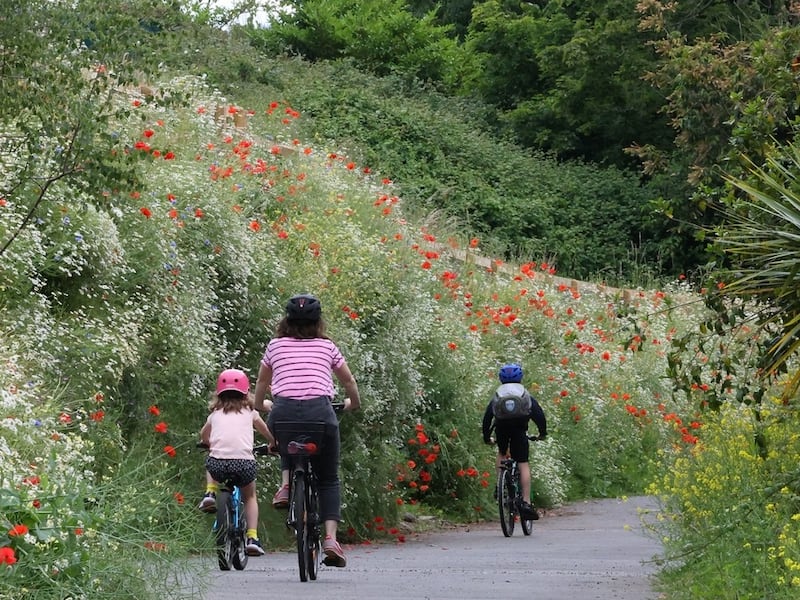
In rural areas it is not as simple as “doing nothing” to allow land to rewild. “On peat lands we need to block drains. There is a need to fence farm animals out of areas and cull deer populations. “We are making some progress. The new CAP (Common Agricultural Policy) is allowing farmers to rewild 30 per cent of land, but this is only applicable to farmers who have fields.” Commonage areas, which may have much more potential, are not part of this plan.
There are some rewilding projects that provide more; not just biodiversity benefits but also powerful carbon sequestration. “Healthy bogs, particularly healthy raised bogs, will take carbon out of the air forever, compared to forests which store carbon for 100 years.”
Fogarty believes the culture war over forest projects is overstated. In the surveys and public consultations there has been “huge public support for forests”. What people hate are the commercial plantations, cliff faces of conifers clear-felled to leave devastated ecosystems in their wake.
Fogarty’s advice to anyone wanting to wild their garden is to make space for wildlife and enjoy what arrives. “You don’t have to be an absolutist.” He has a “resident family of sparrows” and a crowd of starlings as regular visitors. Ants live under the elder that seeded itself. They all feel a little like part of the family.
“Rewilding has been a really positive story. People can see with their own eyes,” Fogarty says. And what they see is the power of an intelligent system.
“Nature is healing” became a consoling idea of the early days of the pandemic, when we marvelled at crystal clear waters in Venice or foxes on deserted city streets. The idea blossomed, and then quickly withered into a jokey meme. But the experience left its mark, and leaves us more open to ideas of rewilding public spaces than we have been for generations. We have the solutions, Fogarty says. One of them is the leap of thinking about how to align with natural forces, to see and believe “I’m part of this system. Now I don’t have to control it or dominate it.”



